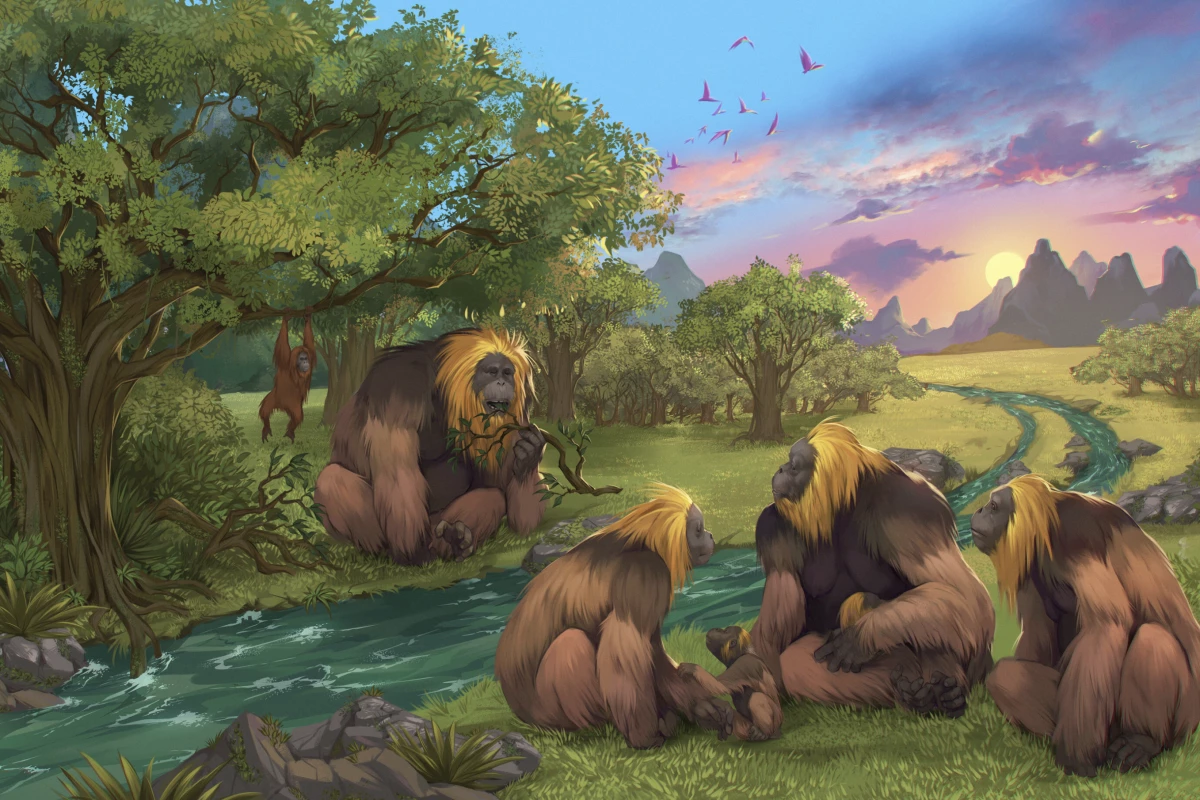For two million years, a 10-feet-tall (305-cm), 660-pound (330-kg) ape towered over other fauna and thrived in its lush forest habitat, until it mysteriously vanished during the late middle Pleistocene. And until now, the extinction of Gigantopithecus blacki, the largest primate to ever walk the Earth, has defied scientific explanation.
In a new study, more than 10 years of research and diverse analysis methods, including the use of lasers to date 600,000-year-old soil, researchers from Australia, the US and China have finally determined what rang the death knell for one of the planet’s most enduring and formidable species.
“The story of G. blacki is an enigma in paleontology – how could such a mighty creature go extinct at a time when other primates were adapting and surviving?” said palaeontologist and co-lead author Professor Yingqi Zhang, from the Institute of Vertebrate Palaeontology and Palaeoanthropology at the Chinese Academy of Sciences (IVPP). “The unresolved cause of its disappearance has become the Holy Grail in this discipline.”
What they discovered was a cautionary tale of how crucial adapting to a changing environment is for species survival: G. blacki, also known as giganto, fell victim to climate change that altered landscapes, seasons and food availability, and the apes, unable to diversify diet and behaviors, ultimately died out between 295,000 and 215,000 years ago.
With the species having been wiped out before humans arrived in the region, all we’ve known about G. blacki has been based on almost 2,000 fossilized teeth and four jawbones. And its existence only came to light in 1935, when anthropologist Gustav von Koenigswald chanced upon several of the huge teeth in a Hong Kong drugstore in 1935, where the large oddities were being sold as ‘dragon tooth' and ground up for use in Chinese medicine.
Since then, scientists have slowly pieced together a biography of G. blacki, with teeth enamel analysis in 2019 revealing that, while closely related to orangutans, the two lineages appeared to have diverged on the ancient phylogenetic tree 10-12 million years ago.
The current study took a huge international network of researchers more than a decade to gather and test evidence from 16 cave sites in Chongzuo and six more in Bubing Basin, in southern China’s Guangxi province.
“The IVPP has been excavating for G. blacki evidence in this region for over 10 years but without solid dating and a consistent environmental analysis, the cause of its extinction had eluded us,” said Zhang.
To establish a timeline, the researchers used six dating techniques to analyze cave sediment and fossils. What they found were 157 distinct radiometric ages. It was combined with behavioral and environmental evidence from the 22 caves, 11 showing the existence of G. blacki, and 11 others of a similar age without.

“It’s a major feat to present a defined cause for the extinction of a species, but establishing the exact time when a species disappears from the fossil record gives us a target timeframe for an environmental reconstruction and behavior assessment,” said co-lead author Kira Westaway, geochronologist associate professor at Macquarie University, one of six Australian institutions involved in the huge project.
Among the dating techniques was luminescence analysis, which measures the energy of photos being released to determine when the fossil-encasing sediment minerals began storing radiation. Uranium series (US) and electron-spin resonance (US-ESR) dating were used to get a read on the G. blacki teeth fossils.
“By direct-dating the fossil remains, we confirmed their age aligns with the luminescence sequence in the sediments where they were found, giving us a comprehensive and reliable chronology for the extinction of G. blacki,” said Renaud Joannes-Boyau, geochronologist associate professor from Southern Cross University.
Pollen measuring, fauna reconstruction, stable isotope analysis of the teeth and the micro-analysis of cave sediments enabled the researchers to gather a clear picture of the environmental conditions leading up to and at the time of the extinction event.
With teeth size also varying, the scientists used trace element and dental microwear textural analysis (DMTA), which showed up a stark contrast in behaviors when the species was doing well, and when it was most certainly not.
“Teeth provide a staggering insight into the behavior of the species indicating stress, diversity of food sources, and repeated behaviors,” said Joannes-Boyau.
At the height of the species’ success, their habitat was a flourishing forest environment that easily serviced G. blacki’s diet of fruit, nuts, seeds and shoots. However, things began to change around 700,000-600,000 years ago, with the forest making way for more sparse grasslands and sporadic seasonal supply of the ape’s dietary staples.
Tooth evidence has revealed that when food was scarce, the apes relied on less nutritious offerings like tree bark. This contributed to the species having less energy to forage across a wide range, reducing its dietary diversity even further. As they began to die out, populations would have also experienced chronic stress from how tough day-to-day survival had become.

On the other hand, their close relatives, orangutans (Pongo spp.), were able to adapt in size, behavior and habitat preferences as the world around them changed, and ultimately prevailed.
“G. blacki was the ultimate specialist, compared to the more agile adapters like orangutans, and this ultimately led to its demise,” said Zhang.
While setting the history record straight, the researchers say knowing precise reasons for the decline of large species is vital for our own timeline.
“With the threat of a sixth mass extinction event looming over us, there is an urgent need to understand why species go extinct,” Westaway added. “Exploring the reasons for past unresolved extinctions gives us a good starting point to understand primate resilience and the fate of other large animals, in the past and future.”
See more on this study and the work that went into resolving the mystery of G. blacki's extinction in the video below.
The research was published in the journal Nature.
Source: Macquarie University






